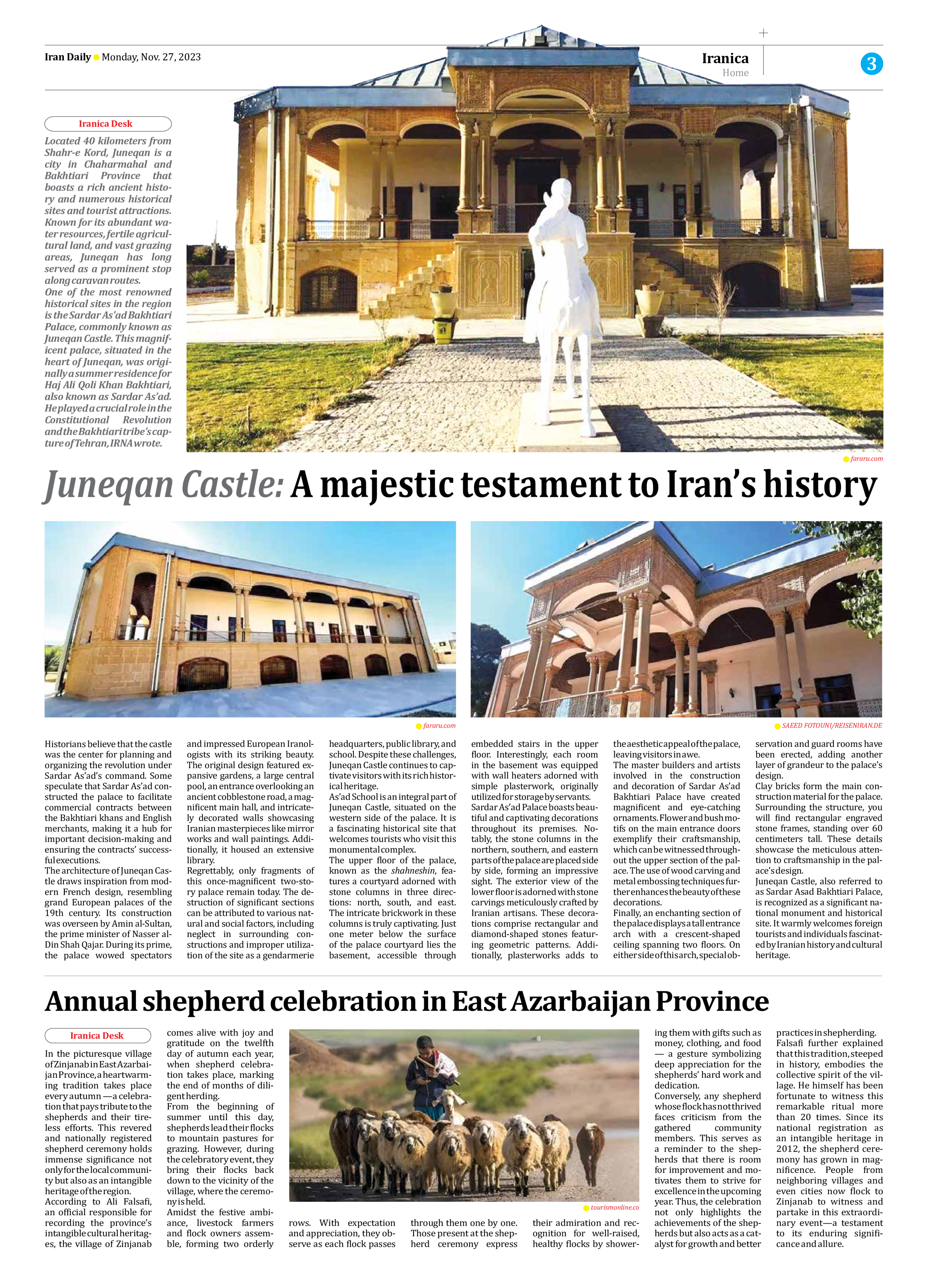
Juneqan Castle: A majestic testament to Iran’s history
Located 40 kilometers from Shahr-e Kord, Juneqan is a city in Chaharmahal and Bakhtiari Province that boasts a rich ancient history and numerous historical sites and tourist attractions. Known for its abundant water resources, fertile agricultural land, and vast grazing areas, Juneqan has long served as a prominent stop along caravan routes.
One of the most renowned historical sites in the region is the Sardar As’ad Bakhtiari Palace, commonly known as Juneqan Castle. This magnificent palace, situated in the heart of Juneqan, was originally a summer residence for Haj Ali Qoli Khan Bakhtiari, also known as Sardar As’ad. He played a crucial role in the Constitutional Revolution and the Bakhtiari tribe’s capture of Tehran, IRNA wrote.
Historians believe that the castle was the center for planning and organizing the revolution under Sardar As’ad’s command. Some speculate that Sardar As’ad constructed the palace to facilitate commercial contracts between the Bakhtiari khans and English merchants, making it a hub for important decision-making and ensuring the contracts’ successful executions.
The architecture of Juneqan Castle draws inspiration from modern French design, resembling grand European palaces of the 19th century. Its construction was overseen by Amin al-Sultan, the prime minister of Nasser al-Din Shah Qajar. During its prime, the palace wowed spectators and impressed European Iranologists with its striking beauty. The original design featured expansive gardens, a large central pool, an entrance overlooking an ancient cobblestone road, a magnificent main hall, and intricately decorated walls showcasing Iranian masterpieces like mirror works and wall paintings. Additionally, it housed an extensive library.
Regrettably, only fragments of this once-magnificent two-story palace remain today. The destruction of significant sections can be attributed to various natural and social factors, including neglect in surrounding constructions and improper utilization of the site as a gendarmerie headquarters, public library, and school. Despite these challenges, Juneqan Castle continues to captivate visitors with its rich historical heritage.
As’ad School is an integral part of Juneqan Castle, situated on the western side of the palace. It is a fascinating historical site that welcomes tourists who visit this monumental complex.
The upper floor of the palace, known as the shahneshin, features a courtyard adorned with stone columns in three directions: north, south, and east. The intricate brickwork in these columns is truly captivating. Just one meter below the surface of the palace courtyard lies the basement, accessible through embedded stairs in the upper floor. Interestingly, each room in the basement was equipped with wall heaters adorned with simple plasterwork, originally utilized for storage by servants.
Sardar As’ad Palace boasts beautiful and captivating decorations throughout its premises. Notably, the stone columns in the northern, southern, and eastern parts of the palace are placed side by side, forming an impressive sight. The exterior view of the lower floor is adorned with stone carvings meticulously crafted by Iranian artisans. These decorations comprise rectangular and diamond-shaped stones featuring geometric patterns. Additionally, plasterworks adds to the aesthetic appeal of the palace, leaving visitors in awe.
The master builders and artists involved in the construction and decoration of Sardar As’ad Bakhtiari Palace have created magnificent and eye-catching ornaments. Flower and bush motifs on the main entrance doors exemplify their craftsmanship, which can be witnessed throughout the upper section of the palace. The use of wood carving and metal embossing techniques further enhances the beauty of these decorations.
Finally, an enchanting section of the palace displays a tall entrance arch with a crescent-shaped ceiling spanning two floors. On either side of this arch, special observation and guard rooms have been erected, adding another layer of grandeur to the palace’s design.
Clay bricks form the main construction material for the palace. Surrounding the structure, you will find rectangular engraved stone frames, standing over 60 centimeters tall. These details showcase the meticulous attention to craftsmanship in the palace’s design.
Juneqan Castle, also referred to as Sardar Asad Bakhtiari Palace, is recognized as a significant national monument and historical site. It warmly welcomes foreign tourists and individuals fascinated by Iranian history and cultural heritage.







